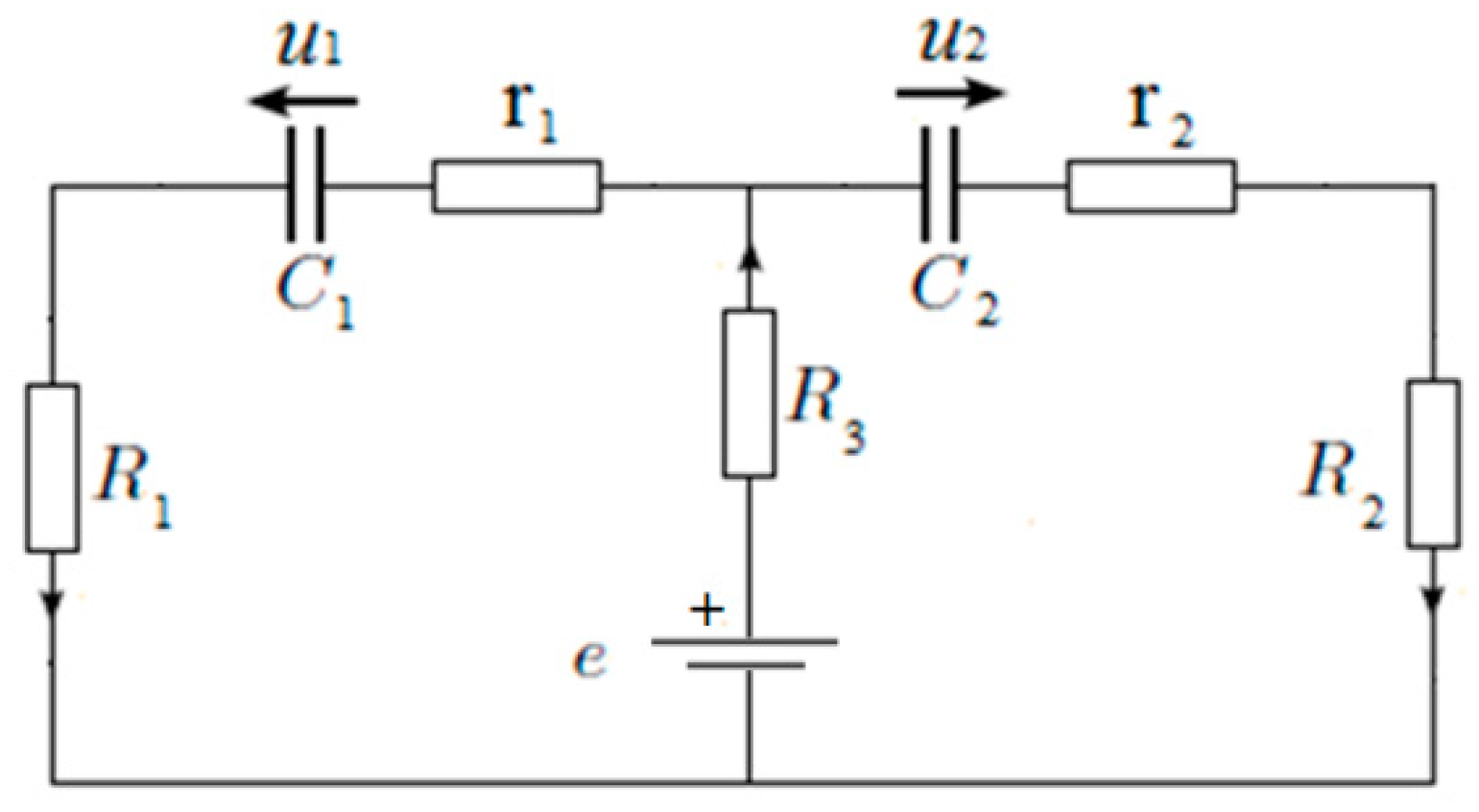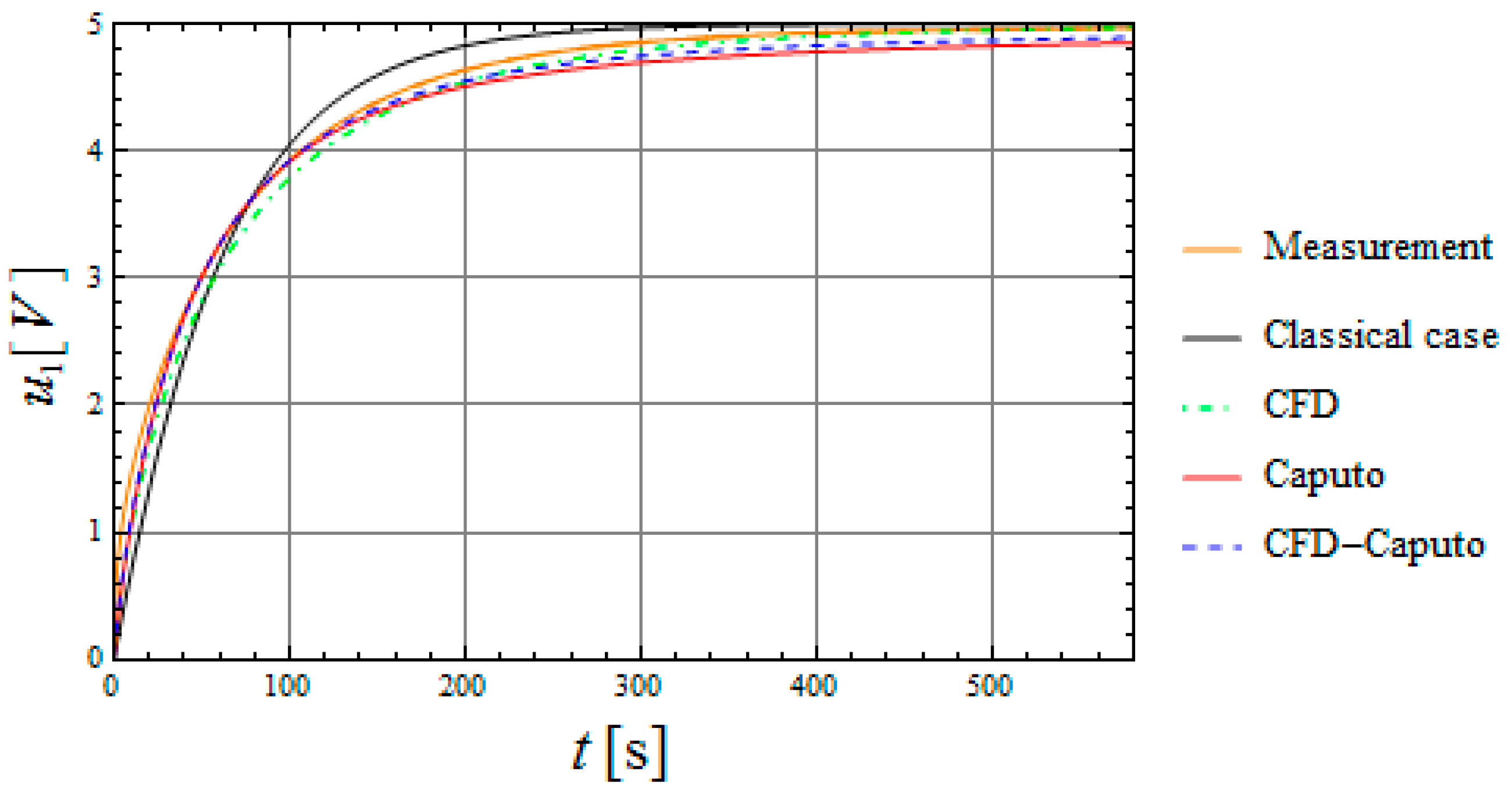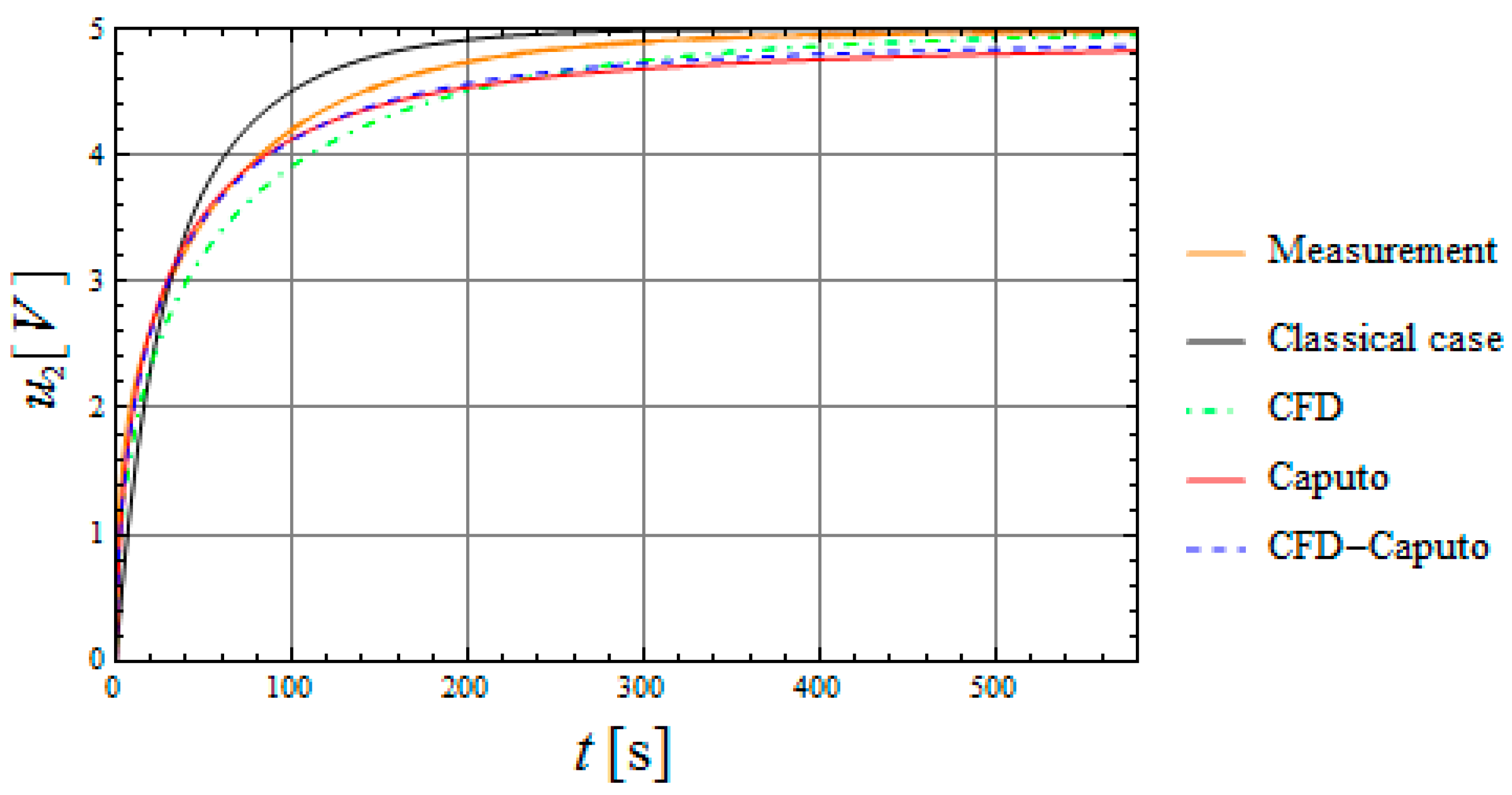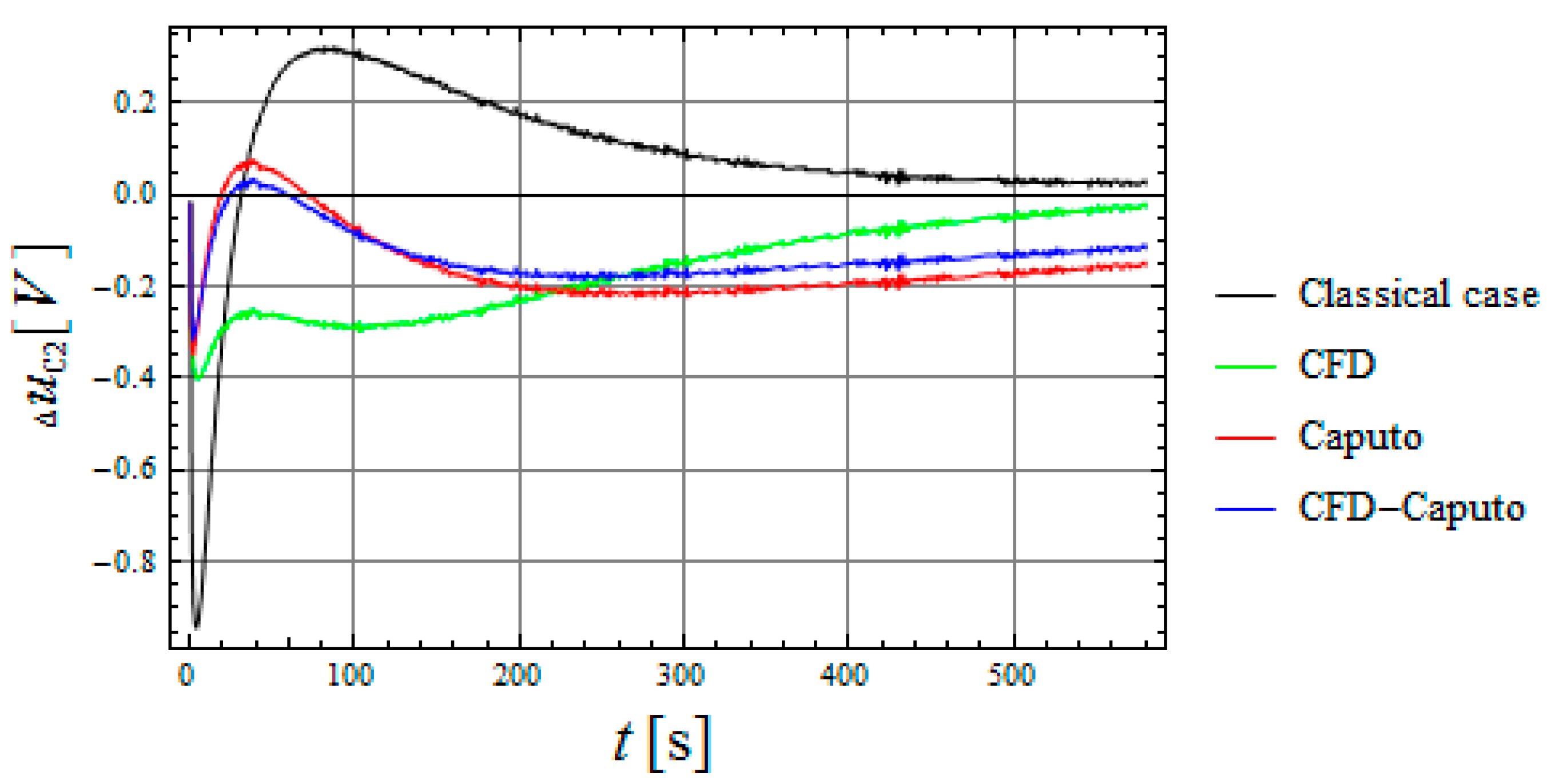Analysis of an Electrical Circuit Using Two-Parameter Conformable Operator in the Caputo Sense
Abstract
1. Introduction
2. Basic Definitions
3. Conformable Operator in the Caputo Sense
4. Fractional Electrical Circuit and General Description of the Problem
5. Conclusions
Author Contributions
Funding
Institutional Review Board Statement
Informed Consent Statement
Data Availability Statement
Conflicts of Interest
References
- Kaczorek, T. Selected Problems in Fractional Systems Theory; Springer: Berlin, Germany, 2012. [Google Scholar]
- Luft, M.; Szychta, E.; Nowocień, A.; Pietruszczak, D. Application of differential-integral calculus of incomplete orders in mathematical modeling of pressure transducer. Coaches. Oper. Tests 2016, 6, 972–976. (In Polish) [Google Scholar]
- Ostalczyk, P. Epitome of Fractional Calculus: Theory and Aplications in Automatics; Lodz Technical University Publishing: Lodz, Poland, 2008. (In Polish) [Google Scholar]
- Liouville, J. Mémoire sur quelques quéstions de géometrie et de mécanique, et sur un noveau genre pour résoudre ces quéstions. J. École Polytech. 1832, 13, 1–69. [Google Scholar]
- Alsaedi, A.; Nieto, J.J.; Venktesh, V. Fractional electrical circuits. Adv. Mech. Eng. 2015, 7, 1–7. [Google Scholar] [CrossRef]
- Grünwald, A.K. Über “begrenzte” Derivationen und deren anwendung. Z. Angew.Math. Phys. 1867, 12, 441–480. [Google Scholar]
- Cioć, R. Grünwald-Letnikov derivative—Analyse in space of first order derivative. In Frontiers in Fractional Calculus, Book Series: Current Developments in Mathematical Sciences; Bentham Science Publishers Ltd.: Sharjah, United Arab Emirates, 2018; Volume 1. [Google Scholar]
- Naeem, I.; Khan, M.D. Symmetry classification of time-fractional diffusion equation. Commun. Nonlinear Sci. Numer. Simul. 2017, 42, 560–570. [Google Scholar] [CrossRef]
- Leo, R.A.; Sicuro, G.; Tempesta, P. A theorem on the existence of symmetries of fractional PDEs. C. R. Math. 2014, 352, 219–222. [Google Scholar] [CrossRef]
- Hashemi, M.S.; Inc, M.; Bayram, M. Symmetry properties and exact solutions of the time fractional Kolmogorov-Petrovskii-Piskunov equation. Rev. Mex. Fıs. 2019, 65, 529–535. [Google Scholar] [CrossRef]
- Caponetto, R.; Dongola, G.; Fortuna, L.; Petráś, I. Fractional Order Systems. Modeling and Control Applications; World Scientific: Singapoure, 2010. [Google Scholar]
- Dzieliński, A.; Sierociuk, D. Ultracapacitor modeling and control using discrete fractional order state-space model. Acta Montan. Slovaca 2008, 13, 136–145. [Google Scholar]
- Jesus, I.S.; Tenreiro Machado, J.A. Comparing Integer and Fractional Models in some Electrical Systems. In Proceedings of the 4th IFAC Workshop Fractional Differentiation and its Applications, Badajoz, Spain, 18–20 October 2010. [Google Scholar]
- Kaczorek, T. Analysis of fractional electrical circuits in transient states. Logistyka 2010, 2, CD-ROM. [Google Scholar]
- Piotrowska, E.; Rogowski, K. Analysis of fractional electrical circuit using caputo and conformable derivative definitions. In Non-Integer Order Calculus and its Applications; Ostalczyk, P., Sankowski, D., Nowakowski, J., Eds.; RRNR 2017. Lecture Notes in Electrical Engineering; Springer: Cham, Switzerland, 2019; Volume 496. [Google Scholar]
- Sikora, R. Fractional derivatives in electrical circuit theory—Critical remarks. Arch. Electr. Eng. 2017, 66, 155–163. [Google Scholar] [CrossRef][Green Version]
- Yavuz, M.; Ozdemir, N. A different approach to the European option pricing model with new fractional operator. Math. Model. Nat. Phenom. 2018, 13, 1–12. [Google Scholar] [CrossRef]
- Yavuz, M.; Ozdemir, N. New numerical techniques for solving fractional partial differential equations in conformable sense. In Non-Integer Order Calculus and its Applications; Ostalczyk, P., Sankowski, D., Nowakowski, J., Eds.; RRNR 2017. Lecture Notes in Electrical Engineering; Springer: Cham, Switzerland, 2019; Volume 496. [Google Scholar]
- Yavuz, M.; Yaşkıran, B. Approximate-analytical solutions of cable equation using conformable fractional operator. New Trends Math. Sci. 2017, 4, 209–219. [Google Scholar] [CrossRef]
- Yavuz, M.; Yaşkıran, B. Conformable derivative operator in modelling neuronal dynamics. Appl. Appl. Math. 2018, 13, 803–817. [Google Scholar]
- Abdeljawad, T. On conformable fractional calculus. J. Comp. Appl. Math. 2015, 279, 57–66. [Google Scholar] [CrossRef]
- İskender Eroğlu, B.B.; Avcı, D.; Özdemir, N. Optimal control problem for a conformable fractional heat conduction equation. Acta Phys. Pol. 2017, 132, 658–662. [Google Scholar] [CrossRef]
- Khalil, R.; Al Horani, A.; Yousef, A.; Sababheh, M. A new definition of fractional derivative. J. Comput. Appl. Math. 2014, 264, 65–70. [Google Scholar] [CrossRef]
- Martínez, L.; Rosales, J.J.; Carreño, C.A.; Lozano, J.M. Electrical circuits described by fractional conformable derivative. Int. J. Circ. Theor. Appl. 2018, 46, 1091–1100. [Google Scholar] [CrossRef]
- Kaplan, M.; Bekir, A.; Ozer, M.N. A simple technique for constructing exact solutions to nonlinear differential equations with conformable fractional derivative. Opt. Quant. Electron. 2017, 49, 266. [Google Scholar] [CrossRef]
- Piotrowska, E. Analysis of fractional electrical circuit with rectangular input signal using Caputo and conformable derivative definitions. Arch. Electr. Eng. 2018, 67, 789–802. [Google Scholar]
- Piotrowska, E. Analysis of fractional electrical circuit with sinusoidal input signal using Caputo and conformable derivative definitions. Pozn. Univ. Technol. Acad. J. Electical Eng. 2019, 97, 155–167. [Google Scholar]
- Piotrowska, E. Analysis of linear continuous-time systems by the use of the Conformable Fractional Calculus and Caputo. Arch. Electrical Eng. 2018, 67, 629–639. [Google Scholar]
- Morales-Delgado, V.F.; Gómez-Aguilar, J.F.; Taneco-Hernandez, M.A. Analytical solutions of electrical circuits described by fractional conformable derivatives in Liouville-Caputo sense. Int. J. Electron. Commun. 2018, 85, 108–117. [Google Scholar] [CrossRef]
- Piotrowska, E. Positive continuous—Time linear electrical circuit. Pozn. Univ. Technol. Acad. J. Electical Eng. 2018, 93, 299–309. [Google Scholar] [CrossRef]
- Kaczorek, T.; Rogowski, K. Fractional Linear Systems and Electrical Circuits; Springer: Cham, Switzerland, 2014. [Google Scholar]
- AbdelAty, A.M.; Radwan, A.G.; Ahmed, W.A.; Faied, M. Charging and discharging RCα circuit under Riemann-Liouville and Caputo fractional derivatives. In Proceedings of the 13th International Conference on Electrical Engineering/Electronics, Computer, Telecommunications and Information Technology (ECTI-CON), Chiang Mai, Thailand, 28 June–1 July 2016; pp. 1–4. [Google Scholar]
- Jiang, Y.; Zhang, B. Comparative study of riemann–liouville and caputo derivative definitions in time-domain analysis of fractional-order capacitor. IEEE Trans. Circuits Syst. II Express Briefs 2020, 67, 2184–2188. [Google Scholar] [CrossRef]
- Elwakil, A.S.; Radwan, A.G.; Freeborn, T.J.; Allagui, A.; Maundy, B.J.; Fouda, M. Low-voltage commercial super-capacitor response to periodic linear-with-time current excitation: A case study. IET Circuits Devices Syst. 2017, 11, 189–195. [Google Scholar] [CrossRef]





| C1 (1 F) | C2 (0.33 F) | |||||
|---|---|---|---|---|---|---|
| Definition | α1 | β1 | Cαβ1 [F/s1−αβ] | α1 | β1 | Cαβ2 [F/s1−αβ] |
| Classical case | 1.000 | 1.000 | 0.911 | 1.000 | 1.000 | 0.211 |
| CFD | 1.000 | 0.761 | 0.424 | 1.000 | 0.761 | 0.091 |
| Caputo | 0.857 | 1.000 | 0.431 | 0.857 | 1.000 | 0.062 |
| CFD–Caputo | 0.914 | 0.884 | 0.412 | 0.914 | 0.884 | 0.071 |
| Definition | C1 (1 F) | C2 (0.33 F) |
|---|---|---|
| χ2 | ||
| Classical case | 47.2 | 46.5 |
| CFD | 17.1 | 42.0 |
| Caputo | 22.9 | 35.0 |
| CFD–Caputo | 12.8 | 23.6 |
Publisher’s Note: MDPI stays neutral with regard to jurisdictional claims in published maps and institutional affiliations. |
© 2021 by the authors. Licensee MDPI, Basel, Switzerland. This article is an open access article distributed under the terms and conditions of the Creative Commons Attribution (CC BY) license (https://creativecommons.org/licenses/by/4.0/).
Share and Cite
Piotrowska, E.; Sajewski, Ł. Analysis of an Electrical Circuit Using Two-Parameter Conformable Operator in the Caputo Sense. Symmetry 2021, 13, 771. https://doi.org/10.3390/sym13050771
Piotrowska E, Sajewski Ł. Analysis of an Electrical Circuit Using Two-Parameter Conformable Operator in the Caputo Sense. Symmetry. 2021; 13(5):771. https://doi.org/10.3390/sym13050771
Chicago/Turabian StylePiotrowska, Ewa, and Łukasz Sajewski. 2021. "Analysis of an Electrical Circuit Using Two-Parameter Conformable Operator in the Caputo Sense" Symmetry 13, no. 5: 771. https://doi.org/10.3390/sym13050771
APA StylePiotrowska, E., & Sajewski, Ł. (2021). Analysis of an Electrical Circuit Using Two-Parameter Conformable Operator in the Caputo Sense. Symmetry, 13(5), 771. https://doi.org/10.3390/sym13050771






